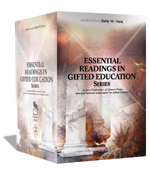Buy all 12 books and SAVE 22%--over $81!
Put the power and knowledge of more than 25 years of research into your hands!
The National Association for Gifted Children series Essential Readings in Gifted Education, edited by Sally M. Reis, is a comprehensive collection of the leading research, theories, and findings that span more than 25 years. Each volume tackles the major issues, chronicles chief trends, and imparts effective models and solutions for gifted education.
Individual volumes edited by prominent leaders in the field of gifted education include:
Robert J. Sternberg: Definitions and Conceptions of Giftedness--This volume explores the multiple faces of giftedness and talent, the validity of available assessments, and how educators can develop giftedness and talent
Definitions and Conceptions of Giftedness
Joseph S. Renzulli: Identification of Students for Gifted and Talented Programs--The articles address and offer solutions to the numerous challenges educators face in their attempts to accurately identify gifted and talented students.
Identification of Students for Gifted and Talented Programs
Linda E. Brody: Grouping and Acceleration Practices in Gifted Education--Various forms of grouping and acceleration are studied in this volume, along with recommendations for implementation that will ensure challenging educational opportunities for gifted students.
Grouping and Acceleration Practices in Gifted Education
Joyce VanTassel-Baska: Curriculum for Gifted and Talented Students--This ready-reference offers decision makers the tools they need to shape a successful and enriching curriculum for gifted students.
Curriculum for Gifted and Talented Students
Carol Ann Tomlinson: Differentiation for Gifted and Talented Students--Focusing on the link between gifted education and general education, the benefits of differentiating curriculum and instruction are discussed.
Curriculum for Gifted and Talented Students
Alexinia Y. Baldwin: Culturally Diverse and Underserved Populations of Gifted Students--This volume addresses the under representation of culturally diverse and/or economically disadvantaged students in gifted and talented programs.
Culturally Diverse and Underserved Populations of Gifted Students
:--This volume explores the multiple faces of giftedness and talent, the validity of available assessments, and how educators can develop giftedness and talent:--The articles address and offer solutions to the numerous challenges educators face in their attempts to accurately identify gifted and talented students.: Various forms of grouping and acceleration are studied in this volume, along with recommendations for implementation that will ensure challenging educational opportunities for gifted students.:--This ready-reference offers decision makers the tools they need to shape a successful and enriching curriculum for gifted students.:--Focusing on the link between gifted education and general education, the benefits of differentiating curriculum and instruction are discussed.:--This volume addresses the under representation of culturally diverse and/or economically disadvantaged students in gifted and talented programs.
:--This volume explores the multiple faces of giftedness and talent, the validity of available assessments, and how educators can develop giftedness and talent:--The articles address and offer solutions to the numerous challenges educators face in their attempts to accurately identify gifted and talented students.: Various forms of grouping and acceleration are studied in this volume, along with recommendations for implementation that will ensure challenging educational opportunities for gifted students.:--This ready-reference offers decision makers the tools they need to shape a successful and enriching curriculum for gifted students.:--Focusing on the link between gifted education and general education, the benefits of differentiating curriculum and instruction are discussed.:--This volume addresses the under representation of culturally diverse and/or economically disadvantaged students in gifted and talented programs.
Susan Baum: Twice-Exceptional and Special Populations of Gifted Students--Gifted students that are at-risk because of learning disabilities, gender issues, and/or economical disadvantages are highlighted in this volume.
Twice-Exceptional and Special Populations of Gifted Students
:--Gifted students that are at-risk because of learning disabilities, gender issues, and/or economical disadvantages are highlighted in this volume.
Sidney M. Moon: Social/Emotional Issues, Underachievement, and Counseling of Gifted and Talented Students--Articles in this volume address the affective needs of special populations of high-ability students, such as underachievers, who are at risk of not reaching their full potential. Preventive strategies and intervention techniques are also discussed.
Social/Emotional Issues, Underachievement, and Counseling of Gifted and Talented Students
:--Articles in this volume address the affective needs of special populations of high-ability students, such as underachievers, who are at risk of not reaching their full potential.Preventive strategies and intervention techniques are also discussed.
Enid Zimmerman: Artistically and Musically Talented Students--Major themes include nature versus nurture in arts talent development, crystallizing experiences, teacher empowerment, and collaboration between school and community members.
Artistically and Musically Talented Students
:--Major themes include nature versus nurture in arts talent development, crystallizing experiences, teacher empowerment, and collaboration between school and community members.
Donald J. Treffinger: Creativity and Giftedness--Misconceptions about the connection between creativity and giftedness are debunked, and dynamic means of recognizing, assessing, and nurturing creativity are discussed.
Creativity and Giftedness
Misconceptions about the connection between creativity and giftedness are debunked, and dynamic means of recognizing, assessing, and nurturing creativity are discussed.
Carolyn M. Callahan: Program Evaluation in Gifted Education--The readings in this volume report on specific program evaluations, and offer critical guidance in the development of assessment instruments for gifted programs.
Program Evaluation in Gifted Education
:--The readings in this volume report on specific program evaluations, and offer critical guidance in the development of assessment instruments for gifted programs.
James J. Gallagher: Public Policy in Gifted Education--Raising some of the most challenging questions, this call-to-arms focuses on what must be done to keep gifted child programs alive and well.
Public Policy in Gifted Education
:--Raising some of the most challenging questions, this call-to-arms focuses on what must be done to keep gifted child programs alive and well.




